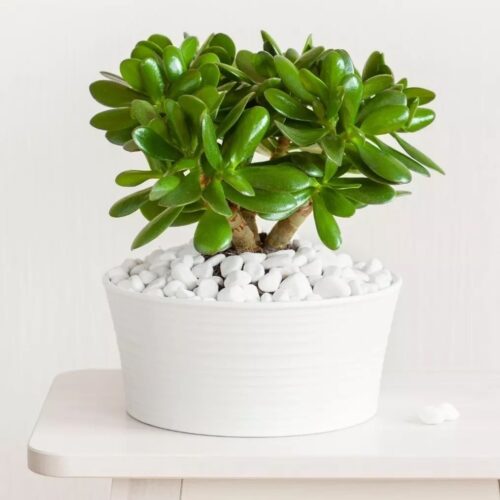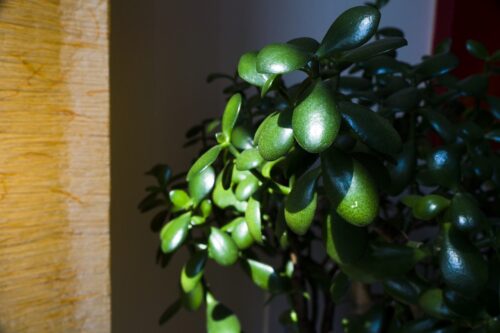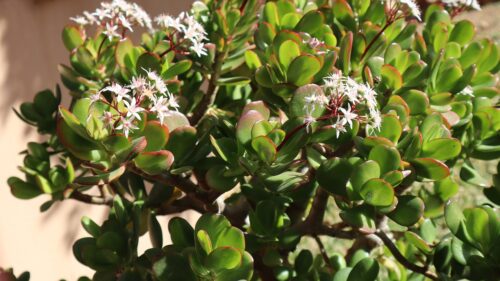Jade Plant Indoor Care is not difficult if you follow the right directions. Check this comprehensive guide for all do’s and don’ts.
Read about jade plant care and have this lucky plant indoors by following the simple instructions in this comprehensive guide.
Botanical Name: Crassula ovata
USDA Zone: 11-12
Common Names: Jade Plant, Money Plant, Dollar Plant, Friendship Plant
Read: Growing a Jade Plant into a Tree
Jade Plant Information

Native to South Africa and Mozambique, the jade plant is a famous houseplant with fleshy, oval-shaped, glossy green leaves and thick woody stems. It grows slowly and can mature up to 3-6 feet tall and 2-3 feet wide. Jade plant flowers rarely indoors; in its native habitat, mature crassula offers clusters of small pink or white, star-shaped blooms in winter.
It is believed that the crassula ovata brings money and prosperity, and that makes it more popular in homes as a houseplant. This easy-to-care plant can live up to 50-70 years in favorable conditions.
Read: Elephant Bush vs. Jade Plant
Varieties of Jade Plant
You can grow common jade plant (Crassula ovata) and other types of crassula as well;
- Lady Fingers Jade
- Tolkien Jade Group
- Pink Jade Plant
- Hummel’s Sunset
- Baby Jade Plant
Read: Kalanchoe Millotii Care Guide
How to Propagate Jade Plant
- Jade plant is easy to propagate; you can grow it from a mature single leaf with a stem. Allow it callus for 4-6 days.
- Dip the cut ends in the rooting hormone.
- Place the leaf on a shallow tray filled with cactus or succulent mix.
- Avoid burying the leaf-cutting in the soil. Keep it in a warm, bright area.
- Mist the leaf-cutting every so often.
- Baby plants and roots will begin to appear near the margins of the leaf; at this point, start to treat and care for the cuttings like an established crassula ovata.
TIP: You can also grow a jade plant from stem cuttings indoors. Just snip off a 4-6 inches long stem cutting from the plant and propagate in a succulent mix. Water the plant when the top 1-2 inches of soil become dry. The cuttings will root in some weeks.
Read: Sedum Nussbaumerianum Care Guide
Best Pot Size
Start the young plant in a 4-6 inch pot with drainage holes, and choose a container that keeps your jade plant in a bit root-bound state; it helps boost growth.
Ideal Growing Conditions for Jade Plant Indoors

Location
Place your well-established jade plants where they receive at least four or more hours of daily sun. They thrive best in a room with south-facing windows. Prevent leaf scorching in young jade plants by exposing them to bright, indirect light.
Soil
Use a succulent mix with a pH of around 6.0 (slightly acidic). Make sure the soil is well-draining, as excessive moisture leads to fungal growth. If you are using an all-purpose potting mix, add some perlite in a 2:1 ratio to help with drainage.
Watering
During summer and spring, keep the soil moist but not wet. Reduce watering in winter to once a month. Drain excess water after a few minutes if you are watering from beneath by allowing the plant to sit in a saucer of water.
Note: Never allow the plant to sit in water; avoid overhead watering as well.
Temperature and Humidity
During summer, jade plants prefer 65 to 70 F temperature, and in winter, at night, plants need a cool environment down to 55 F. The jade plants are not frost tolerant, so bring them indoors when the temperature drops to or under 50 F.
Read: Graptopetalum Paraguayense Care Guide
Jade Plant Care

Fertilizer
Feed your jade plants moderately, and use a dilute mix of standard liquid houseplant fertilizer. You can also use fertilizer made for succulents and cacti. Use a 20-20-20 fertilizer at one-quarter strength on established plants, while on young plants, apply fertilizer with less nitrogen.
Repotting
Repot your jade plant when needed, ideally in the warm season; keep these points while repotting a succulent:
- Before repotting, ensure the soil is dry, then carefully remove the pot.
- Gently shake off the old soil from the roots and remove the rotted and dead roots in the process.
- Place the plant in a new pot and fill the potting mix.
- Don’t water the plant for a week or so, then resume to water lightly; this will reduce the chance of root rot.
Pests and Diseases
Mealybug is a common pest that leaves white patches on your crassula ovata where the foliage connects to the stems. Use a cotton ball or rubbing alcohol to wipe off mealybugs; the reason behind suggesting this technique is succulents or jade plants are sensitive to oils and insecticides. Apart from that, scale insects or spider mites can be another threat, which you treat in the same way.
Prevent root rot by avoiding overwatering and keeping the soil moist but not waterlogged.
Toxicity
Jade plants are toxic to dogs and cats, though the effects are not fatal. If your pets ingest any part of the plant, they may feel lethargic and nauseous. The plant is also slightly toxic to humans and can result in skin irritation, diarrhea, and vomiting.



